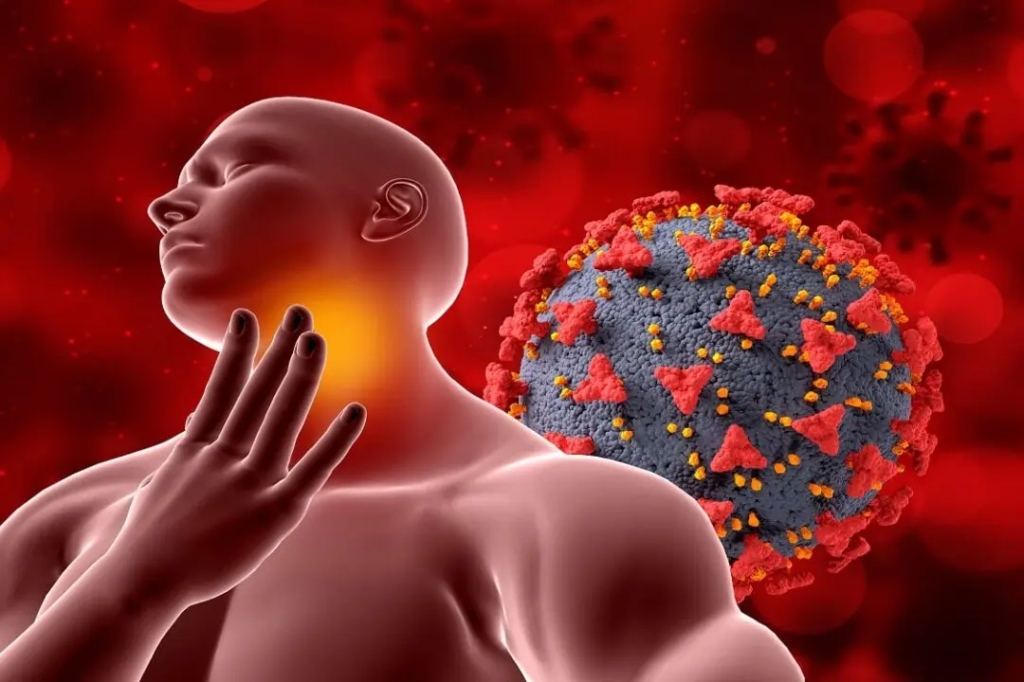
One case report involving a 15-year-old girl suggests COVID-19 may cause paralysis in the vocal cords.
While it’s known that the COVID-19 virus can damage the lungs, it can be equally harmful to many other organs.
On Dec. 19, 2023, the journal Pediatrics published a case report detailing a 15-year-old girl who, after contracting COVID-19, developed complications leading to bilateral vocal cord paralysis and necessitating a tracheostomy for breathing. The tracheostomy device remained in place for 15 months before it was finally removed.
The girl experienced symptoms of nasal congestion, fever, and fatigue two weeks before the onset of vocal cord paralysis. She then tested positive for COVID-19 using a home antigen test. Nine days later, she exhibited symptoms of acute shortness of breath that worsened during physical activity, prompting her admission to the emergency department at Massachusetts General Hospital.
The patient displayed intermittent noisy breathing, but blood oxygen saturation was normal. Furthermore, a series of tests, including those for COVID-19, all returned negative results. Notably, she has a history of asthma and anxiety. Suspecting an asthma attack, the doctor prescribed steroids and bronchodilators, but there was no improvement. The patient also underwent speech therapy, but it similarly yielded no results.
After admission, the patient continued to experience noisy breathing and developed difficulty swallowing, weakness on the left side, “pins and needles,” and unsteady gait. She underwent consultations with otolaryngology, psychiatry, neurology, speech pathology, and neurosurgery. A laryngeal scope examination revealed a severe bilateral reduction in her vocal cords’ range of motion. The weakness on her left side and the pins-and-needles feeling were determined to be likely functional, but the possibility of a COVID-19-related cause could not be ruled out.
To alleviate respiratory symptoms, the doctor injected botulinum toxin (Botox) into the girl’s throat muscles—a proven method for treating certain throat conditions in children. Unfortunately, the symptoms persisted. Subsequently, the patient underwent a tracheostomy, which relieved the symptoms. However, her vocal cord function remained impaired, and as of the writing of the case report, she has been dependent on a tracheostomy for 13 months.
COVID-19 in Children
Children comprise 18 percent of all reported COVID-19 cases in the United States. Previous research has shown that the COVID-19 virus can lead to neurological complications, including headaches, seizures, and peripheral neuropathy. This recent case suggests that vocal cord paralysis may be another neurological sequela of the virus.
Dr. Danielle Reny Larrow, the lead author of the case report and a resident at Massachusetts Eye and Ear, a teaching hospital of Harvard Medical School, stated in a press release that considering the prevalence of the COVID-19 virus in children, any child presenting with breathing, talking, or swallowing symptoms after recent COVID-19 infection should be evaluated for this potential new complication. She emphasized that such symptoms could easily be attributed to more common conditions like asthma.
Dr. Christopher Hartnick, director of the Division of Pediatric Otolaryngology and the Pediatric Airway, Voice, and Swallowing Center at Massachusetts Eye and Ear, stated that after the submission of the case report, doctors were finally able to remove the tracheostomy device from the patient. This allowed her to attend her high school graduation ceremony and prom, marking 15 months since her initial tracheostomy procedure.
COVID-Induced Vocal Cord Paralysis in Adults
According to a case report released by researchers from the Mount Sinai Health System in the United States in 2021, from May 2020 to January 2021, at least 16 adults were identified with vocal fold paralysis or muscle weakness. Patients consistently reported a change in their voice when initially experiencing upper respiratory tract infections and COVID-19 symptoms. The time from symptom onset to seeking medical attention varied from one to seven months, with an average of three months. Four patients underwent laryngeal electromyography (LEMG) examinations, confirming a 100 percent diagnosis of neuropathy.
The report described the mechanisms of neuropathy following viral infection, including direct viral infection causing acute inflammation of the nerves, viral fusion with DNA in the neural ganglia, where it remains dormant until reactivated by external factors, and immune-mediated response leading to antibody production. These antibodies then destroy the myelin sheath enveloping neurons, resulting in neuropathy. Post-viral vagal neuropathy commonly occurs following an acute upper respiratory tract infection, resulting in impairment of both sensory and motor functions of the vagus nerve.
According to the Perelman School of Medicine at the University of Pennsylvania, vocal cord paralysis can be temporary or permanent. Bilateral vocal cord paralysis is rare and may pose a risk of suffocation, as closely situated vocal cords can obstruct airflow into the trachea and lungs. Surgical intervention may be necessary in cases of permanent vocal cord paralysis.